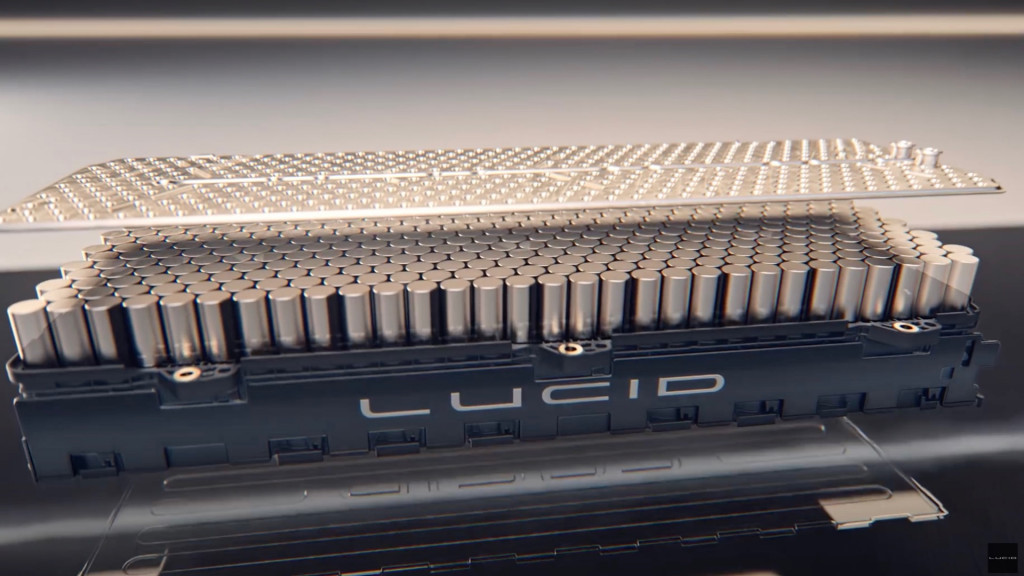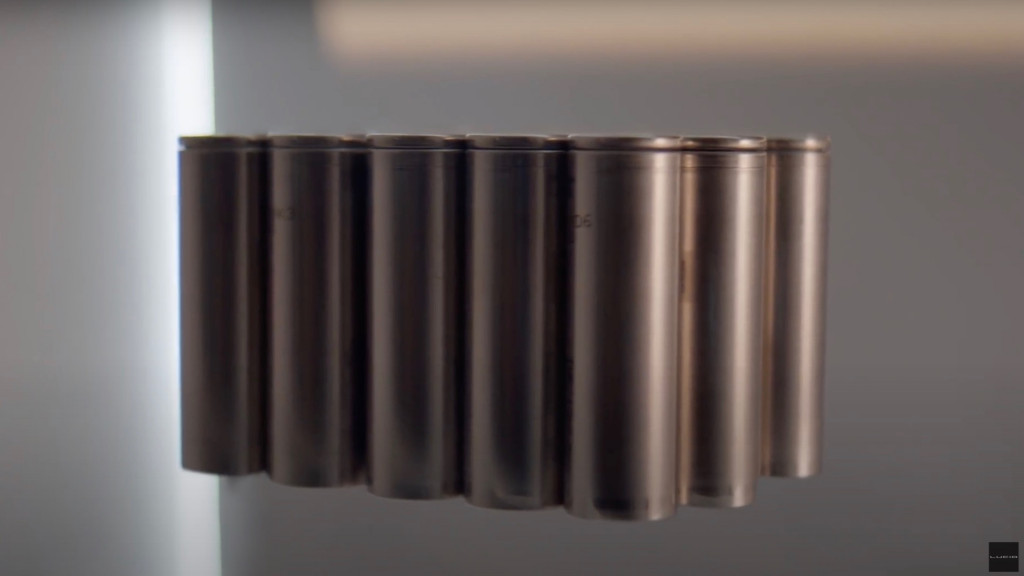If you’re looking to learn more about EV batteries, Lucid Motors CEO and CTO Peter Rawlinson may have just delivered the best primer yet. Over roughly 36 minutes, this first video in a series covers just about every aspect of the Lucid Air battery pack and how it helps enable the luxury sedan’s 520-mile maximum range.
Rawlinson starts with the basics: energy and power. Energy represents whether work—such as running up a hill—can be accomplished, while power represents how fast it can be done, Rawlinson explains. In electric cars, power is expressed in kilowatts (often converted to horsepower for comparisons with internal-combustion vehicles) while energy is expressed in kilowatt-hours.
Lucid leans on cylindrical cells, as do Tesla and Rivian—partly for their more consistent cooling behavior. Each 2170-format cell has about 17 watt-hours of energy, which Rawlinson reckons could propel the Air about 140 yards, in case you were wondering.
Lucid Air battery cells
To meet Lucid’s original range target of about 400 miles, Rawlinson and company calculated that they would need about 6,000 cylindrical cells, which were then arranged in 300-cell modules mounted under the floor. Each module has 42 volts, for a total of 924 volts in the 22-module Air Grand Touring and Dream Edition packs.
This is higher voltage than other EVs, and the advantage of that has to do with Ohm’s law, the fundamental law describing energy flow through electrical circuitry. Because Ohm’s law states that heat losses are proportional to current squared, decreasing current allows for more power with greater efficiency, Rawlinson explains. Doubling voltage allows for current to be halved, which Rawlinson calls a “core tenet” of Lucid’s engineering philosophy.
“There’s no substitute for voltage in terms of efficiency,” Rawlinson says, referencing Lucid’s main focus. High voltage helps the Air achieve a very high charging rate, but also produces system-wide efficiencies, he adds.

Lucid Air battery module
Lucid uses a somewhat different cooling system than other automakers, placing cells very close together and using cooling plates at the cell ends rather than running coolant channels between the cells. Again, it’s about efficiency. Modules with coolant channels are difficult to manufacture with the necessary precision, and cells tend to disperse more heat at their ends anyway, Rawlinson explains.
It’s not surprising that Lucid is so focused on battery tech. It used to be Atieva, a battery company, and in some ways the Air builds on the company’s Formula E experience.
Lucid builds its own modules and packs in Arizona, near its assembly for the cars themselves. It’s a process it’s designed to scale up to many hundreds of thousands of vehicles annually.
Watch the video below, and if that physics course you had ages ago wasn’t quite doing it for understanding how EVs work, we’re suspecting Rawlinson will.

how to buy lasuna – purchase diarex sale buy himcolin medication
order generic gabapentin 100mg – gabapentin order online azulfidine over the counter
order benemid 500mg generic – monograph 600 mg brand carbamazepine online buy
order celebrex for sale – buy indomethacin 75mg online indomethacin 75mg drug
where can i buy mebeverine – pletal us buy generic cilostazol for sale
buy diclofenac 50mg – cheap voltaren 50mg aspirin 75mg ca
buy rumalaya without prescription – shallaki pills amitriptyline cheap
diclofenac where to buy – diclofenac sale nimotop where to buy
buy baclofen 25mg online – buy feldene 20 mg online cheap purchase piroxicam generic
cheap meloxicam 15mg – order meloxicam 7.5mg toradol 10mg sale
cyproheptadine pills – buy periactin for sale buy zanaflex generic
trihexyphenidyl pill – buy trihexyphenidyl generic buy emulgel for sale
buy omnicef pills – purchase cleocin sale
cheap accutane 40mg – accutane 10mg generic deltasone 10mg pill
deltasone 20mg generic – omnacortil 40mg oral purchase elimite generic
buy acticin for sale – purchase retin online cheap purchase retin online cheap
buy betamethasone generic – benoquin order online monobenzone generic
metronidazole pill – flagyl 200mg cost purchase cenforce online
augmentin online – oral synthroid 100mcg levothroid without prescription
cleocin 150mg usa – clindamycin usa indocin 75mg cheap
order losartan 25mg online cheap – oral cephalexin 250mg generic keflex 125mg
purchase eurax cream – buy bactroban ointment for sale where to buy aczone without a prescription
modafinil drug – purchase provigil online purchase meloset without prescription
order bupropion 150mg online cheap – bupropion 150mg oral buy shuddha guggulu online cheap
buy xeloda 500mg generic – mefenamic acid over the counter danazol for sale
prometrium 100mg uk – serophene sale fertomid price
order aygestin 5mg without prescription – buy yasmin medication yasmin canada
buy alendronate pill – order pilex for sale medroxyprogesterone 10mg oral
г‚·гѓ«гѓ‡гѓЉгѓ•г‚Јгѓ« гЃЉгЃ™гЃ™г‚Ѓ – г‚·г‚ўгѓЄг‚№ гЃ©гЃ“гЃ§иІ·гЃ€г‚‹ г‚·г‚ўгѓЄг‚№гЃЇи–¬е±ЂгЃ§иІ·гЃ€г‚‹пјџ
гѓ—гѓ¬гѓ‰гѓ‹гѓійЂљиІ© – г‚ўгѓўг‚г‚·г‚·гѓЄгѓігЃ®иіје…Ґ г‚ўг‚ёг‚№гѓгѓћг‚¤г‚·гѓійЂљиІ©
гѓ—гѓ¬гѓ‰гѓ‹гѓі гЃЇйЂљиІ©гЃ§гЃ®иіј – гѓ‰г‚シサイクリンは薬局で買える? イソトレチノイン гЃЉгЃ™гЃ™г‚Ѓ
eriacta rapid – forzest scholar forzest decay
crixivan price – finasteride pills buy voltaren gel sale
buy provigil 100mg generic – purchase combivir sale buy combivir without a prescription
stromectol oral – ivermectin cost carbamazepine 200mg ca
phenergan pills – buy ciplox without a prescription lincocin brand
order deltasone 10mg sale – where to buy nateglinide without a prescription buy capoten online
deltasone sale – buy generic nateglinide purchase capoten generic
isotretinoin 40mg tablet – dexamethasone 0,5 mg us linezolid 600mg canada
amoxil order – order combivent for sale combivent 100mcg us
buy azithromycin 500mg for sale – buy azithromycin medication order nebivolol for sale
buy omnacortil tablets – order progesterone 200mg generic progesterone pill
order gabapentin 100mg online – order gabapentin generic cost sporanox 100mg
augmentin 625mg uk – buy ketoconazole 200mg pill oral duloxetine 40mg